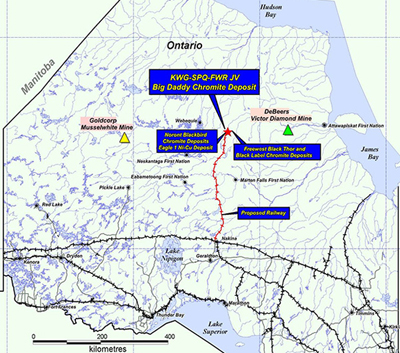KWG looks to China to support its proposed railway.
Hours after KWG Resources CSE:KWG updated its Ring of Fire rail proposal, CBC reported that a highly anticipated government-funded road study simply called for more study. Specifically excluded from its scope, the network added, was a route to the potential mining sites.
CBC obtained a copy of the document entitled All Season Community Road Study, Final Report June 30, 2016 and quoted this excerpt:
“This study has always been considered to be focused on an all-season community service road rather than an industrial road to connect to the Ring of Fire mineralized zone. Its intention was always to (1) link the four communities together; and (2) link the communities to the existing highway system.”
Release of the federally and provincially funded report had been expected since its scheduled completion in June. Ontario has pledged $1 billion to Ring of Fire infrastructure and asked Ottawa for matching funds.
According to CBC, “Ontario mining minister Michael Gravelle said those [transportation] discussions are ongoing and there is no timeline for coming to definitive answers. The study was led by the First Nations and it’s up to them to release it to the public, he added.”
“This study was going to be the one that was going to give us the road map forward, literally,” the network quoted NDP MP Charlie Angus. “Now it’s just going to be kicked down the road for more delay, more study and more excuses.”
Besides the report’s disappointing lack of a call to action, news that the study excluded the Ring’s mineral deposits will take many observers by surprise. Noront Resources TSXV:NOT favoured an all-season east-west road that would connect its deposits and four native communities with Highway 599 at Pickle Lake, which leads south to a Canadian National Railway TSX:CNR line at Savant Lake.
KWG maintained that rail would be necessary to develop the region’s chromite assets. Norontcountered that its nickel-copper-platinum-palladium deposits should be developed first, pending better market conditions for chromite. A road would be the faster, cheaper option, the company argued.KWG has said Chinese investors have shown interest in a railway.
Hours before CBC posted its exclusive, KWG announced that a “conditional bankable feasibility study” for its proposed railway should be complete by year-end. The company stated it has “agreed on the deliverables and timetable” with China Railway First Survey and Design Institute Group to examine a 340-kilometre north-south route linking its properties with CN at Exton. Late last month KWGannounced Quebec-based CANARAIL Consultants would provide professional services and data for the China Railway feasibility study proposed in a January MOU.
Noront’s flagship Eagle’s Nest nickel-copper-PGE project reached feasibility in 2012. In an optimistic news release earlier this month, the company stated it “anticipates that mine construction will begin in 2018 when road construction starts, resulting in first concentrate production in 2021.”
Noront’s other Ring of Fire assets include the Blackbird chromite deposit and the Black Thor and Black Label chromite deposits. Noront and KWG hold 70%/30% respectively of the Big Daddy chromite deposit and 85%/15% of the McFaulds copper-zinc deposits. Noront is KWG’s largest shareholder.
Noront recently signed a definitive agreement to buy a 75% stake in MacDonald Mines Exploration’s (TSXV:BMK) regional properties, increasing Noront’s portfolio to around 75% of the Ring’s staked claims.
KWG also holds an 80% option on the Koper Lake project with its Black Horse chromite deposit.
Both companies have faced recent public criticism. Last week CBC reported the Neskantaga First Nation issued a “cease and desist” order to Noront, after the company announced a drill program. An online video posted by KWG drew widespread censure for its display of bikini-clad women.

